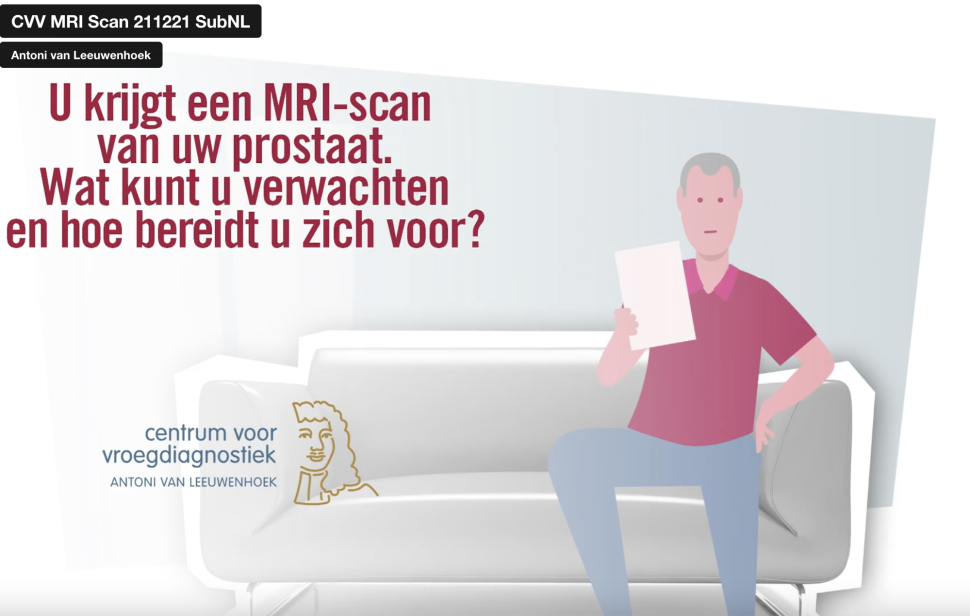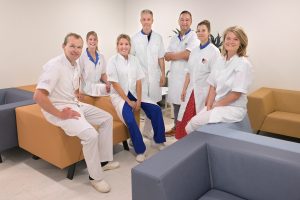What to expect from prostate diangostics?

Diagnostics in 5 steps
Step 1. Preparations at home
After your registration/referral, you will receive a comprehensive questionnaire from us by email and our app.
Step 2. PSA test
Prior to the intake, we take a blood sample to measure the PSA level at that moment.
Step 3. Intake and examinations
We combine the intake interview with a series of examinations. We aim to conduct all examinations in one day.
- Transrectal ultrasound (via the anus) to assess the size of the prostate.
- Rectal examination. This is also done via the anus.
- If necessary, an MRI scan.
- We discuss the outcomes of the examinations.

Step 4. Biopsy
If the intake and examinations (step 3) show that this is necessary, we will take a biopsy. Sometimes this can be done on the same day, while other times we schedule a follow-up appointment. During a biopsy, small pieces of tissue are taken from the prostate for further examination.

Step 5. Biopsy results
You will receive your results after approximately 7 days. These results can be provided to you via video call if you prefer. You won’t need to come back to the Center.
Results of the prostate cancer examination
There are three potential outcomes:
- No prostate cancer found
This is good news. However, we recommend monitoring your elevated PSA levels with your general practitioner.
- Prostate cancer has been detected, but is slow-growing
The tumor is still small and grows at a very slow pace. This gives us the option not to intervene immediately. This would mean that you will be monitored by the NKI Center for Early Diagnostics. This is known as ‘active surveillance.’
- Prostate cancer has been detected
If we diagnose you with prostate cancer, we will refer you for treatment. Our Center only provides the diagnosis. We collaborate with the Prostate Cancer Network Netherlands to be able to provide the best care possible. You may be referred to the Netherlands Cancer Institute, or another hospital closer to your home.
Useful information
-
Diagnostics in 9 stepsQuick overview of the steps involved

-
The personal app is your guideEverything you need to know, from your first consultation until your results (Currently only available in Dutch)

-
What is a MRI scan and biopsyWhat to expect in two clear videos

-
There are 3 possible outcomesWhat to do when you receive the results of the follow-up examination?


Our friendly professionals work together towards early diagnostics and scientific research. You may meet them at our Center.
Prostate-specific antigen (PSA) is a protein produced by the prostate. PSA levels can only be measured in men and are done with a simple blood test. Elevated PSA levels may signify the presence of prostate cancer, but the elevated levels could also be caused by something harmless.
We cannot draw that conclusion based solely on your PSA levels. Normal PSA levels range between zero and four micrograms per liter of blood. Higher levels are considered elevated. This PSA increase can also be related to aging, prostate inflammation, or a benign condition. Elevated PSA levels can indicate prostate cancer, but not necessarily. Additional diagnostics will provide more clarity.
In the case of a slowly growing form of prostate cancer, the tumor is still small and grows very slowly. In this situation, active treatment is not necessary. However, you will remain under the care of our Center. This is what we mean by active surveillance.
No, definitely not. It is the most common form of cancer in men aged 55 and older. In 2020, around 13,000 men in the Netherlands were diagnosed with prostate cancer. Of all the men diagnosed with cancer, 21% had prostate cancer.
What we know so far is that men of African origin and men with first-degree relatives who have passed away from prostate cancer have a significantly higher risk of developing the disease themselves. Based on scientific research, to which our Center also contributes, we are gaining more insight into the risk factors.
Unfortunately yes. It is a myth that nearly all older men get prostate cancer and that no one dies from it. We still see too many cases in which people were diagnosed too late when the cancer has already spread. Early diagnosis and more knowledge about risk factors should help us better determine which men need to be screened and when.
There may be a hereditary predisposition and an increased risk. We look at prostate cancer in first- or second-degree relatives: father, son, brother, grandfather, and grandson.
During a biopsy, the skin between your scrotum and anus and the tissue between the skin and the prostate are numbed with a thin needle. Despite the anesthetic, the biopsy, which involves removing small pieces of tissue, can feel sensitive. It helps to try to relax during the procedure.
No, you don’t need to fast or have an empty stomach before your biopsy. You can eat and drink normally.
Some people may feel light-headed after the procedure. We do not recommend driving or biking after the procedure. We recommend that you bring someone with you who can take you home.
You will receive your results within one week, usually during a video call, so you won’t need to travel to the NKI Center for Early Diagnostics again. You will most likely receive the appointment confirmation for this video call after your biopsy, by email and in your app.
